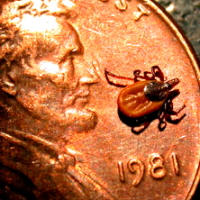Friday Health Focus: Summer Hosts A Rash of RisksBy Susan Bush
12:00AM / Friday, April 21, 2006
 | | How tiny is a tick? This University of Wisconsin Entomology Department photo shows an adult-sized tick - after a feeding! |
Summer sunshine can create an inviting outdoor arena for family fun and games but ultraviolet rays, hungry bugs, and shiny green leaves may spell big health trouble for those who fail to follow some simple safety steps.
The Sun And Skin Cancer
Skin cancer is on the upswing in this country; according to information made available by the U.S. Department of Health and Human Services Centers for Disease Control and Prevention, skin cancer is the most common cancer diagnosed in the nation. Basal cell and squamous cell cancers are considered to be "highly curable," according to the CDC information, while malignant melanoma cancers are considered to be more dangerous and less likely to respond to treatments.
Protecting the skin from ultraviolet rays from either the sun or from sources such as tanning beds is believed to be the top skin cancer prevention strategy. The advice offered by numerous prevention sources, including the Skin Cancer Prevention organization, is easy to follow.
Prevention measures include avoiding direct sun exposure between 10 a.m. and 4 p.m.. Those who are outdoors during those hours should seek shade, wear wide-brimmed hats to protect the face, and slather on sunscreen with a 15 or higher SPF. A recommended sunscreen application is 1 ounce [2 tablespoons] spread over the body 30 minutes prior to going outside. Re-apply the sunscreen every two hours, according to information available at a www.skincancer.org Internet web site.
Newborns should be kept out of the sun entirely, and babies age six months old and over should be covered with sunscreen.
Self-examination of the skin should occur on a regular basis so that any unusual spots or moles can be found. A physician should conduct a professional skin examination on a yearly basis.
UV rays may penetrate vehicle and residential windows and can cause eye damage. UV rays contribute to cataracts, macular degeneration, and eyelid cancers, according to information at www.skincancer.org.
Several products have received a Skin Cancer Foundation "Seal Of Recommendation". UV protective vehicle window film, UV protective residential window film, a UV blocking face mask, and sunglasses that offer protection against UV rays have been awarded the seal.
There is no demographic that is safe from skin cancer, however, those who have light complexions, light hair and light colored eyes are at a greater risk of skin cancer. A family or personal history of skin cancer also increases the risk, as does a long-time, chronic exposure to the sun. A history of childhood sunburns raises a person's risk of skin cancer, according to CDC information.
Trouble From Ticks
Ticks are headliners on the list of seasonal spoilers and the next three months-May, June, and July - are prime time for tick-borne illnesses including Lyme Disease, according to information provided by the CDC.
Lyme Disease is spread through the bite of the black-legged, or deer, tick. Most Lyme Disease is transmitted via immature ticks called "nymphs,' which are mots prevalent during the spring and early to mid-summer months.
However, Lyme Disease has been diagnosed in New England in August and September after individuals reported detecting ticks on their bodies during those months.
In most cases, the tick must remain on a human body for 36 to 48 hours before Lyme Disease transmission occurs. Adult ticks are capable of spreading Lyme Disease but because they are larger than the nymphs, they may be detected and removed more quickly.
Tick exposure is greatest in wooded areas and areas that border woodlands and yards, however, ticks may be carried into low-risk areas on clothing or by pets or other animals.
Prevention measures include avoiding areas likely to host ticks during May, June, and July, or, if hiking or camping in an area that may include ticks, use an insect repellent containing a 20 to 30 percent concentration of DEET [use a formula with a 10 percent concentration for children].
Permethrin may be used on clothing such as pants, socks, and shoes; according to the CDC, one application kills ticks on contact and may remain effective on clothing that has been washed. Permethrin should NOT be applied directly on skin.
When in wooded areas, wear long-sleeved clothing and pants with full leg length.Tuck pants into boots or socks and tuck shirts into pants to help keep any ticks away from the skin. Light-colored clothing makes spotting ticks easier, and taping borders where pants are tucked into socks or shirts are tucked into pants may further reduce the risk of tick bite.
When returning to the indoors, check clothing, skin, scalp, and hair for any ticks, and if a tick is found on clothing, remove the tick. A tick found with its' head imbedded into skin should be removed with tweezers and should NOT be squeezed with fingers, according to CDC information.
Lyme Disease is most often treated with a series of antibiotics. Symptoms include a circular "bull's eye" rash that appears on 70 to 80 percent of those infected with the disease. It may appear between 3 -30 days after a tick bite, according to CDC information. The rash most often expands gradually after it appears and may feel warm but not painful. Symptoms also include feeling chills, experiencing fever, joint pain, muscle aches,headaches, and swollen lymph nodes. Left untreated, the disease may cause heart palpitations and dizziness, severe headaches and neck stiffness.
Anyone who believes that they may have been bitten by a tick or shows signs of Lyme Disease should contact a physician immediately. There are medical tests that may confirm the disease and lead to treatment.
Poison Plants
Poison ivy, poison oak, and poison sumac plants and vines can cause an unpleasant, itchy rash. The greenery trio grow almost everywhere in the United States [notable exceptions, according to the American Academy of Dermatology, are Hawaii and Alaska], and over 10 million Americans develop an allergic reaction rash after exposure to the plants every year.
Poison ivy shows up as a vine throughout the East, the Midwest, and the South, while in the Northeast, the West, and around the Great Lakes region, the plant may grow as a shrub.
Whether shrub or vine, the plant hosts a three-leaflet leaf that generated a generations-old warning "leaves of three, let it be."
Poison sumac grows along bogs, swamps, and areas of standing water, while poison oak usually appears as a shrub in the Eastern United States.
All three plants contain a colorless oil called urushoil. The sap is present in the leaves, roots, and stems of the plant and is responsible for the blistering, oozing, itching rashes that often develop after contact with a poison plant.
Allergic reactions may develop after direct contact, such as touching, indirect contact, such as touching an object that has been in contact with the oil [the oil may stick to pet fur], and via airborne contact, according to information available at a www.aad.org Internet web site.
"When urushoil gets on the skin, it begins to penetrate in minutes," according to web site information. "A reaction appears, usually within 12 to 48 hours."
That reaction often includes redness, swelling, and the appearance of small blisters.
Extreme, severe cases of poison ivy, oak or sumac may require medical intervention.
Those who believe that they have been exposed to the plants may find some help by washing all exposed areas in cold water as soon as possible. Hoses, streams, or lakes may be used as water sources for washing. Clothing should be washed as quickly as possible, and people must take care that exposed clothing not touch rugs or furniture, because urushoil may transfer from the clothing.
Cool showers and applications of calamine lotion may relieve some itching and soaking in lukewarm baths with an oatmeal or baking soda solution may also provide some relief.
Prescription medication may arrest a poison plant reaction if used soon after the exposure, according to AAD information.
"Prescription cortisone can halt the reaction if used early," the information states, and suggests contacting a physician to discuss cortisone use if exposure is known and past reactions have occurred.
Additional information about Lyme Disease may be acquired at a www.cdc.gov web site.
Additional information about skin cancer may be acquired at a www.skincancerprevention.org and a www.skincancer.org Internet web site.
Susan Bush may be reached via e-mail at suebush@iberkshires.com or at 802-823-9367.
|



















